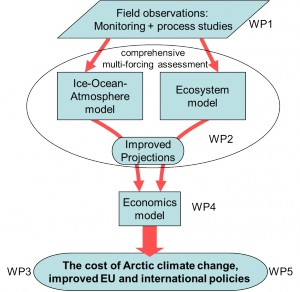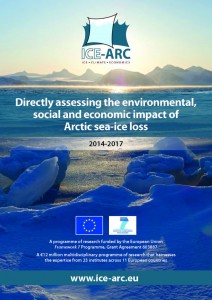The ICE-ARC project aims to understand and quantify the multiple stresses involved in the change in the Arctic marine environment. Particular focus is on the rapid retreat and collapse of the Arctic sea ice cover and to assess the climatic (ice, ocean, atmosphere and ecosystem), economic and social impacts of these stresses on regional and global scales.
It is not possible to look at one aspect of this system in isolation; a coupled atmosphere/cryosphere/ocean/ecosystem approach is needed. Our observations will focus on reducing the uncertainty in understanding of Arctic physical processes which are vital in climate and ecosystem change and which may not be adequately represented in present models.
Results of the observational programme will be fed into an ice-ocean-atmosphere model which, after validation, will make projections – with reduced uncertainties – of the rate and nature of future changes in the ice cover, ocean structure and atmospheric temperature and circulation. In parallel with this an ecosystems model will perform the same role for marine living resources.
The resulting projections of the two models will be fed into an economic impact model (PAGE-ICE) that is specially reconfigured for cryosphere-driven impacts. This will calculate the impacts of the projected physical changes upon the global economic and social system, including those of the Arctic region itself.
This will be the first time that a leading global impact model has been coupled with a physical climate model to directly assess the economic impact of observed and projected climate change events. It is being applied to the oceanic region of greatest current concern to the global community because of the speed of visible change there.
The outputs of the entire project, will undoubtedly lead to more effective policy and management options for societal responses to climate change, and because of this we have an extensive dissemination and engagement programme within ICE-ARC.
ICE-ARC (Ice, Climate, Economics – Arctic Research on Change) is a programme funded by the European Union’s 7th Framework Programme. It is a 4 year project that started on the 1st January 2014, and will look into the current and future changes in Arctic sea ice – both from changing atmospheric and oceanic conditions. We will also investigate in a robust way, the consequences of these changes both on the economics of the area, and social aspects such as on indigenous peoples.
The challenge
The Arctic marine environment is experiences change at an unprecedented pace which is very likely caused by greenhouse gas induced global warming. The ICE-ARC project aims to understand and quantify the multiple stresses involved in the change with a particular focus on the rapid retreat and collapse of the Arctic sea ice cover and to assess the climatic (ice, ocean, atmosphere and ecosystem), economic, and social impacts of these stresses on regional and global scales.
Project Objectives
- Improved climate prediction for the Arctic Ocean and the reduction of uncertainties in those predictions;
- Improved understanding of climate change impacts on marine ecosystems;
- Assessment of socio-economic vulnerabilities, both to the peoples of the north and to the planet as a whole;
- Input to improve EU and international Arctic marine policies to cope with the implications of an increasingly ice-free Arctic;
- Improved understanding of the living resources for Arctic human communities;
- Effective policy and management options for societal responses to climate change.
It is not possible to look at one aspect of this system in isolation; a coupled atmosphere-cryosphere-ocean-ecosystem approach is needed. The approach of the project will therefore include an integrated programme of multi-disciplinary observations, especially involving the use of autonomous platforms and a comprehensive multi-forcing assessment involving both regional (Arctic) and global Earth system models.
Methodology
Observations made will focus on reducing the uncertainty in understanding of

Arctic physical processes which are vital in climate and ecosystem change, and which may not be adequately represented in present models. Results of the observational programme will be fed into an ice-ocean-atmosphere model which, after validation, will make projections – with reduced uncertainties- of the rate and nature of future changes in the ice cover, ocean structure and atmospheric temperature and circulation. In parallel with this an ecosystems model will perform the same role for marine living resources.
The resulting projections of the two models will be fed into an economic impact model (PAGE-ICE) that is specially reconfigured for cryosphere-driven impacts. This will calculate the impacts of the projected physical changes upon the global economic and social system, including those of the Arctic region itself.
Expected Results
This will be the first time that a leading global impact model has been coupled with a physical climate model to directly assess the economic impact of observed and projected climate change events. It is being applied to the oceanic region of greatest current concern to the global community because of the speed of visible change there.
The outputs of the entire project will undoubtedly lead to more effective policy and management options for societal responses to climate change.
ICE-ARC will produce significant impacts for Europe by:
- Improved climate prediction abilities for the Arctic Ocean and its connection to the globe
- Reduction of uncertainties in those predictions;
- Improved understanding of climate change impacts on marine ecosystems;
- Improved understanding of socio-economic vulnerabilities and resilience regarding peoples of the north and the planet as a whole;
- Improved EU and international Arctic marine policies to cope with the implications of an increasingly ice-free Arctic;
- Improved understanding of the marine living resources for Arctic human communities;
- Effective policy and management options for societal responses to climate change;
- Empowering of communities to build capacity towards ensuring sustainable livelihoods, in accordance with their cultural needs;
- First time quantification of projected physical change impacts on the fully global (including Arctic) economic and social system, from an integrated assessment model (PAGE-ICE). This will inject urgency into the debate about appropriate action.
- Quantification of the impacts of Arctic marine change along with the costs of policies to mitigate or adapt to it.



